U-Tiki Beach Waterfront Restaurant & Bar
- 561-406-2210
- email us
- Jupiter, Florida, United States
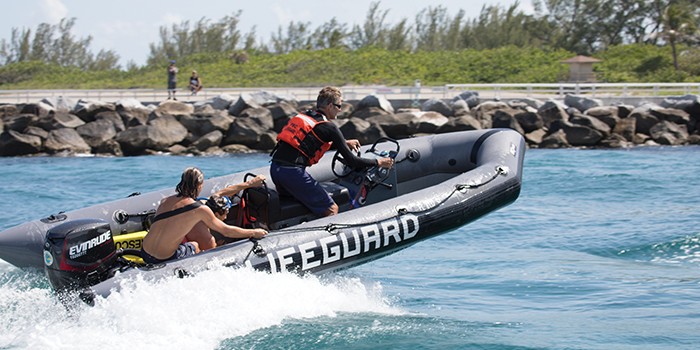

JUPITER, FL – June 29, 2017 – While spending the day at one of our Jupiter beaches, reveling in views and feels composed of sunny skies, palm trees, and the ocean breeze, you wouldn’t think danger looms near—or would you? Fortunately, you don’t have to, since there are silent guardians nearby always looking out for you. Nestled as the eagle’s eye of the beaches, the Palm Beach County Ocean Rescue North District (ORND) lifeguards have their sights set on preventing potential dangers as their daily duties. They vigilantly sit atop their white wooden posts along the coast, ready to put their lives on the line at a moment’s notice. Even though they don’t ask for credit or acclaim, one thing is for sure, these lifeguards are local superheroes.
Such heroics were manifested by ORND lifeguards Tammy Moynihan and Rick Welch not too long ago. It was their quick-thinking tactics that resulted in the rescue of two women in great peril. The incident took place on the sandbar east of the mouth of the Jupiter Inlet: The rough sea conditions on that day caused the two women to be thrown overboard from the boat they were in. Amidst seven-foot swells and heavy chop, the boat driver panicked and continued out of the area to eliminate the chance of the boat being capsized; meanwhile, the women fought for their lives. Hastily preparing for the rescue ahead, the ORND lifeguards threw on their gear and sprinted to the inflatable rescue boat in front of the tower stationed at DuBois Park. With only minutes to spare, Tammy plunged into the water to save the victims as Rick steered the boat away to maintain stabilization. With due diligence, she was able to secure the women in rescue tubes. Once Rick saw his chance between the large sets of waves, he was able to pull back to the scene and retrieve Tammy and the boaters. With relief in their eyes and adrenaline pumping through their veins, the lifeguards returned the women to safety at the DuBois Park docks. They provided the victims with oxygen and EMT medical care for the bumps and bruises that the two women accrued during the incident before the Palm Beach County Fire Rescue unit arrived on scene. Without the assistance of this lifeguard team, the boaters wouldn’t have had any chance of survival.
“It’s a pretty dangerous occupation at times,” says Brian Bowen, Training Officer of the North District. “Saving lives is our job.”
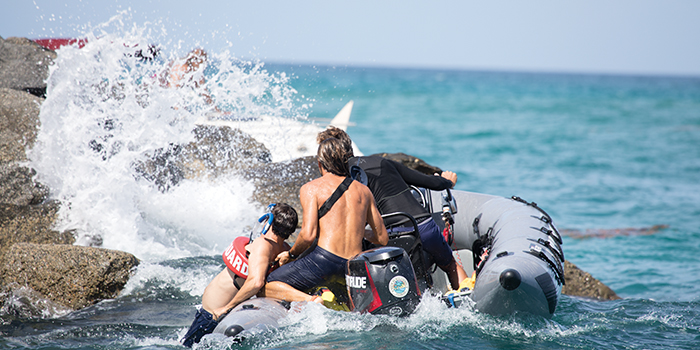
Living in a town that is centered around marine sporting activities, these local heroes are highly-trained CPR-certified and mostly EMT-certified, professionals who attend to any perilous situation that may arise. The ORND includes the Jupiter and Juno areas that consists of seven parks, spanning from Loggerhead to Coral Cove. Each district is staffed with a supervisor, captain, training officer, and lieutenant stationed at each park, along with the 17 to 23 guards on duty at a time. As full-time lifeguards, they are on watch seven days a week year-round, from 9AM to 5:20PM. Becoming a lifeguard is no simple process. In order to gain a position on this incredible team, one must complete a two-week, 80-hour course that teaches basic training, as well as acquire information from the Emergency Medical Systems (EMS) books for trainees. It is only when one is finished with training and beach operations, that he or she is cleared to work.
Many incidents that occur at our beaches remain out of the public eye, but when they do make the media, the responding lifeguards usually go unrecognized. Just as the elite service that is provided to the community through fellow protection agencies such as the police, Fire Rescue, and Coast Guard departments, the ORND provides safety and medical care as well. This year, the North District contributed to the achievement of the Florida Beach Patrol Chiefs Association awarding Palm Beach County’s Ocean Rescue lifeguards as the “beach patrol of the year.” The association also named Palm Beach County’s lifeguard, Larry Russell, as the state of Florida’s lifeguard of the year. The North District has attributed to this accomplishment through growing their success rates over the year by 30 percent on their beach attendance, minor and major medical attention, and rescues.
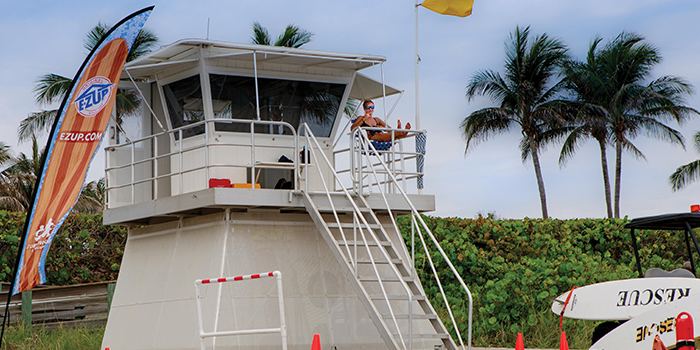
“Our focus is on preventative lifeguarding; we monitor our beaches daily to observe for hazardous areas based on weather and ocean conditions. We are in the safety business. Our number one mission is to prevent drowning; this requires constant vigilance when people are in the water,” says Brian.
Daily duties for the Jupiter Beach lifeguards include morning drills prior to the start of shifts, where the guards are put through practical scenarios simulating a variety of real-world rescues or medical emergencies. When at their posts, they must be on the lookout for any possible dangers that may arise with patrons and boat traffic on the VHF Channel 16—the marine VHF radio frequency designated to distress, urgency, and safety priority calls that is monitored 24 hours a day by Coast Guards and lifeguards all over the world.
Not only are the guards aware of ocean activity, but they are proactive about informing the public about the current state of the water, potential risks, ways to stay safe, and active marine life. They advise beachgoers to be aware of their own limitations and are trained to detect and recognize individual’s abilities. “We call it proactive lifeguarding,” states Brian. “That’s one of the main ingredients in being a good lifeguard. You can never be too cautious, even when it may look like a mild day.”
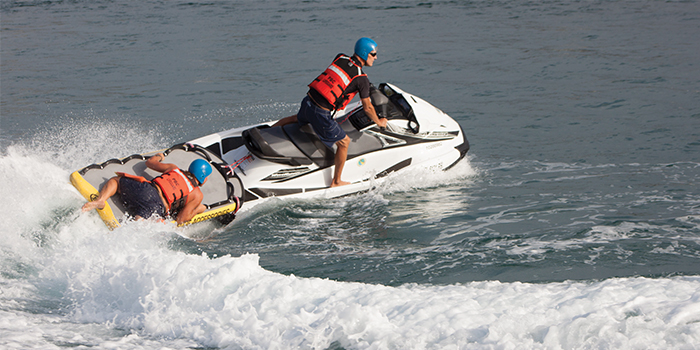
When hazardous situations do emerge, the ORND team responds depending on the type of incident. To assess the situation as first rescuer, the lifeguard will determine how many victims (patrons in distress) there are, what equipment is needed (rescue tubes and fins, rescue board, or jet ski) depending on the surf conditions, and how far from shore the victims are. If backup is needed, they will radio their fellow guards who will quickly respond to the scene with any backup rescue or medical equipment that may be needed.
In addition to riding tides and saving lives, the ORND team competes in lifeguard tournaments around the nation. This year, the United States Lifesaving Association (USLA) is holding the Southeast Regional James P. “Mac” McCarthy Memorial Lifesaving Championship in the nearby city of Delray Beach from July 18th to the 19th, in which the lifeguards that patrol our beaches plan to compete in. If they succeed at qualifying for Regionals, they will be headed to the USLA National Lifeguard Championship that is going to be held in Daytona Beach from August 9th to the 12th, where the top guards will battle for the title.
But this is not the only goal that the ORND team sets their sights on. One of their biggest objectives is to recognize their day-to-day labor as a “Special Risk Profession.” What this designation means for the lifeguards, is that they would be under the same risk protection that other safety agencies are given in the case that a guard may be harmed during a rescue. It takes strong, self-less individuals to be up for the job in order to keep our community safe and those good deeds should be acknowledged.
“Ocean lifeguards are a full-time integral part of the emergency medical services (EMS) system. The lifeguards are the first responders to a scene and provide EMT standard care when they respond to a medical emergency in the park. Stationed at our local beachfront parks for the public safety, ocean lifeguards are equipped with oxygen, as well as tools to care for trauma and medical emergencies. If a 911 call is made somewhere else in the park or nearby before the lifeguards are informed, Fire Rescue dispatch will radio the guards to respond to the scene first and provide any medical care to victims before a medical agency unit arrives,” affirms Brian. “So next time you see one of us at your favorite Jupiter Beach, feel free to say hello! Not only are we knowledgeable about the ocean environment, but also the local area if you need information or are new to the town.”
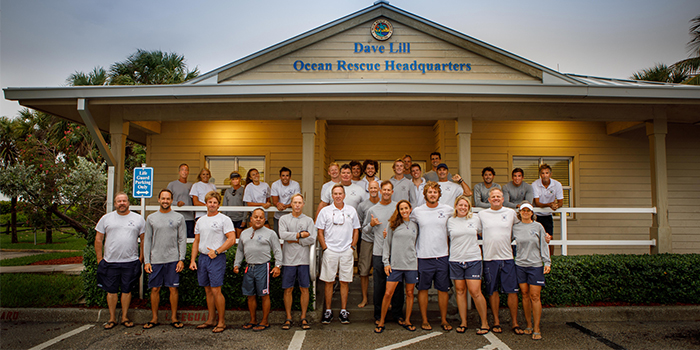
The Dave Lill Ocean Rescue headquarters is home to the Unsung Heroes residing at the Juno Beach Pier
Pictured here are 30 of our local lifeguards:
Front row starting at left - Mike Hutchinson, Chase Robertson, Russ Gehweiler, Len Rodriguez, Larry Russell, Dave Taylor, Rick Welch, Lou Kanitsch, Jessica Ventura, Justin Sullivan, Tiffany LaCasse-Johnson, Phil Harris and Garren Bolash; Middle - Rick Welch; Back row starting at left - Rob Rogerson, Julia Leo, Tammy Moynihan, Kodi Cabral, Lee Norwood, Brian Reagan, Andy Bermingham, Cam Wagner, Pablo Perez, Shane Campbell, Scott Henderson, Sam Van Ornam, Dan Barnickel, Ben Demonstranti, Dylan Owens, Andrew Logan and Brian Bowen